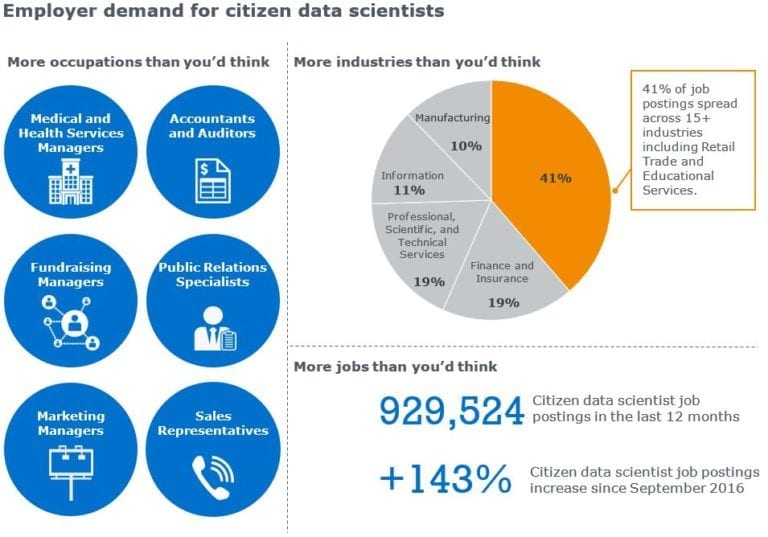Think your graduates don’t need data analytics? Think again.
Teaching analytics to your non-quantitative students prepares them for the nearly one million citizen data science roles we’ve found. The term “citizen data scientists” refers to professionals whose primary job function falls outside specialized data analysis, but who use data analytics in their work.
As organizations rely more heavily on data analysis to make decisions, jobs beyond the information and technology fields increasingly require data analysis. For example, marketing managers now must both conduct marketing campaigns and assess those campaigns’ performance using analytics. Employers seek professionals across occupations who combine mastery of role-specific skills with competency in data analytics.
Analysis of citizen data scientist job postings reveals employers exhibit high demand across diverse occupations and industries. Employers seek professionals with data analytics skills in occupations with primary job functions far removed from data analytics, including medical and health services managers and public relations specialists. In fact, the top four industries for citizen data scientists account for only 59% of job postings, with the rest spread over other industries.

What does this mean for today’s continuing education leaders?
To serve current and aspiring citizen data scientists across a wide range of fields, continuing education leaders should:
1. Offer highly customizable certificates. This allows current or aspiring citizen data scientists to tailor short-term offerings to their particular career and skill-building objectives. These certificates can then serve a broad audience. For example, Indiana University’s online data science certificate allows students to choose among any course in the data science program to customize the certificate to their needs. Continuing education units can build certificates with existing general data analytics courses to keep startup costs low, rather than investing in new courses on data analytics in a particular field.
2. Add analytics tracks within non-analytics graduate degrees. This improves the marketability of both the degrees and graduates. A wide range of programs from MBAs to computer science master’s now include analytics tracks. Northwestern University, for example, has added a sports analytics track within its existing Master’s in Sports Administration to attract aspiring sports business professionals who require analytics fluency. Add an analytics track to an existing, successful degree program to boost enrollments and enhance existing programs at a relatively low cost.
More Blogs

As fintech transforms jobs, higher ed must decide how to prepare students
